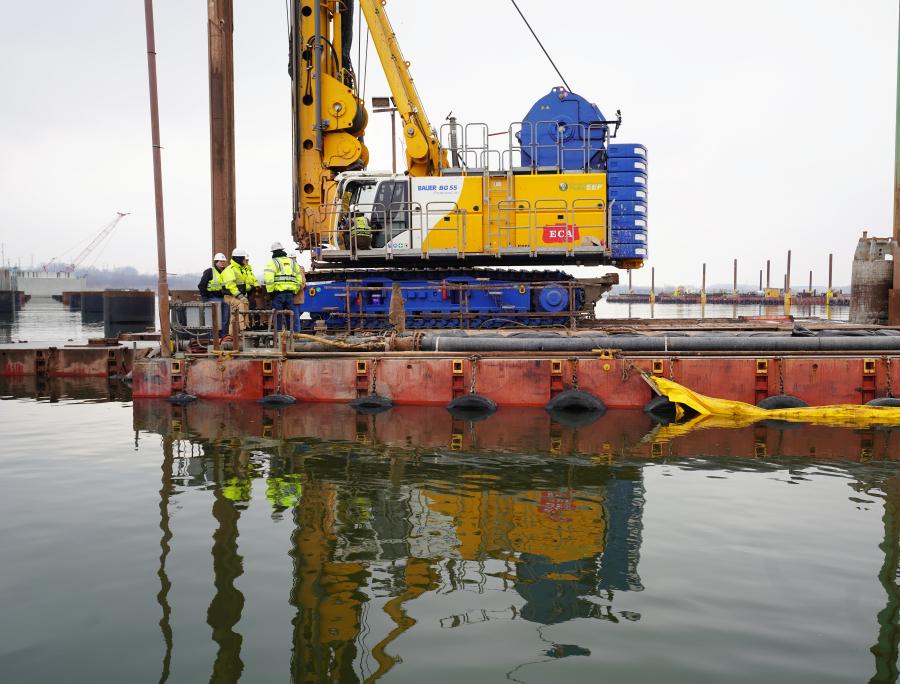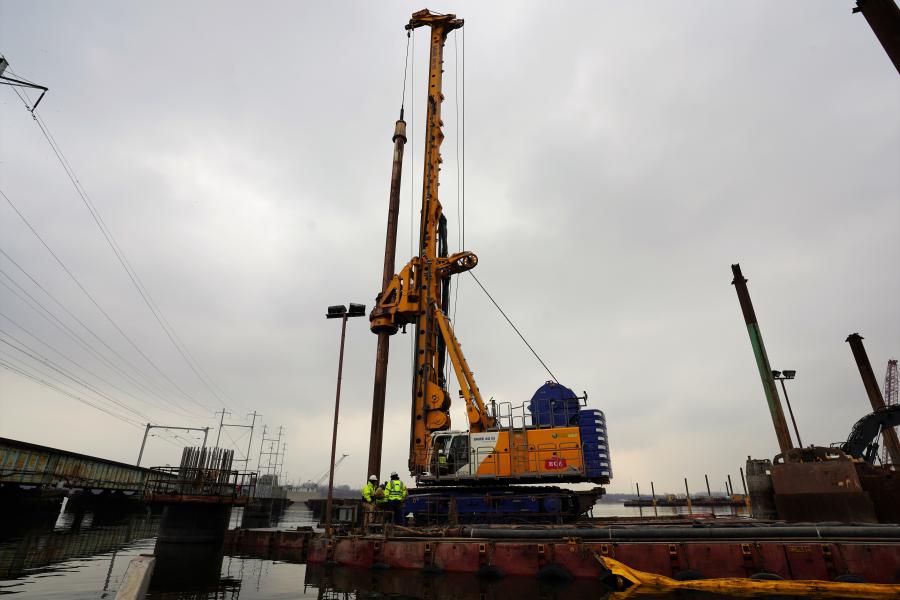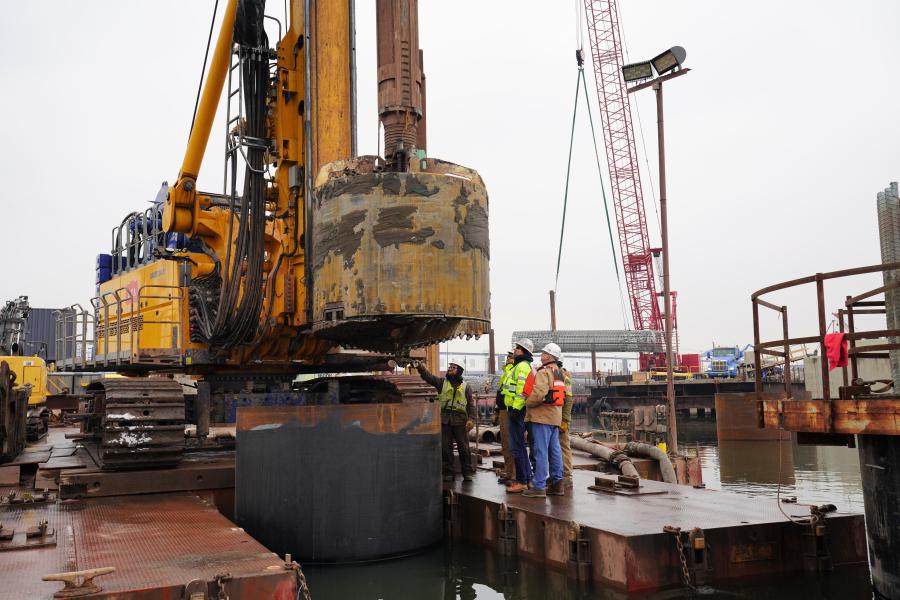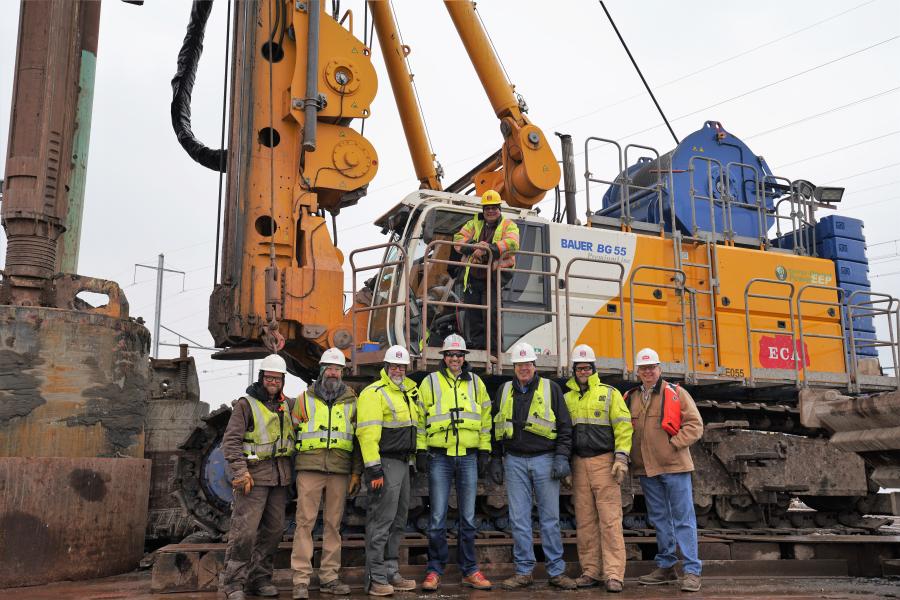Members of the ECA and Harms teams are pictured with the barge-mounted BG 55 on the Raritan River Bridge project. (Brian Fraley photo)
George Harms Construction Company continued work on the replacement of the Raritan River Bridge on a frigid January day as a major winter storm barreled toward New Jersey. This determination, along with a unique decision-making strategy centered on a specific piece of equipment, are keeping this critical infrastructure project on track.
The material under the riverbed largely dictated the need for a rig the size of the BAUER BG 55. The upper layers were soft, silty clay underlain by varying depth sand layers. Beneath that was dense clay and Siltstone.
A group of key project executives from Harms and Equipment Corporation of America (ECA) gathered on the shoreline as work progressed and crews secured the barges holding the equipment.
"We can handle cold temperatures and snow but our biggest nemesis out here is the wind," said Jason Hardell, senior vice president of operations. "That's why we all have beards."
This 112-year-old bridge carries an active New Jersey Transit line across the river from Perth Amboy to South Amboy. Damaged by Superstorm Sandy in 2012, the new span will incorporate structural designs and materials to bolster its defenses against severe weather.
In May 2020, Harms was awarded a contract to install 87 drilled shafts across the Raritan River in configurations from two to 10 shafts per pier. It was the first of three construction phases that will replace the bridge with a lift span. This bridge represents the largest project Harms has ever done in terms of dollar value, but not in terms of scope.

ECA and Harms gathered for a key ceremony in October 2020 to commemorate the purchase of the BG 55.
Building the BG 55 into the Bid
The selection of the BG 55 was founded on a 30-plus year business relationship and friendship between ECA New York, New Jersey Regional Sales Manager Bruce Langan and Harms President Emeritus Tom Hardell.
Harms was awarded this project when the original low bidder retracted its bid. No stranger to $200-million-plus bridges, Harms wasted no time mobilizing and starting work in July 2020.
Harms worked with ECA's Director of BAUER Product Sales and Service Gordian Ulrich to spec the BG 55 into the project during the pre-bid phase. His career started in 2007 at BAUER Maschinen's method development department in Germany and he has been involved with various drilling applications on a global scale.
Other brands of equipment were considered, but Harms concluded that only the BG 55 could cost-effectively drill 8-ft.-diameter shafts up to 240 ft.
"We went out on the limb and purchased it before we were even low," said President and CEO Rob Harms.
The smaller BAUER BG 40 also was considered, but lacked the winch capacity Harms needed. With the massive Kelly bar, tooling, and heavy clay, the BG 55 was the only choice.
ECA had the rig shipped from BAUER Maschinen in Germany to the Port of Newark and hauled to the Harms waterfront facility in Newark, N.J. Once assembled, the BG 55 crawled onto a 200-ft.-long Flexifloat Barge and was floated to the Raritan River Bridge site. This barge would serve as its mobile working platform.
Barge stability was critical with the 118-ft.-tall BG 55 mast subjected to heavy winds during drilling. The barge is constructed of Flexifloats and the configuration is unique and specifically designed for this project and this application. Its 10-ft.-wide sections in 10- and 20-ft. lengths snap together like Legos, so Harms had the flexibility to add and remove.
Six hydraulic spuds with 24-in. diameter pipes anchored the barge to the soft riverbed. Despite the added stability, Harms and ECA had to overcome up and down movement every time the Kelly bar moved.
Harms worked with Flexifloat at the pre-bid stage to design the barge around the BG 55. The polymer slurry tanks on the opposite side served as a counterweight. The hurdle Harms had to overcome was that the weight fluctuated during drilling as the Kelly bar turned and slurry was pumped to the BG 55 to support drilling.
"We had to analyze different drilling scenarios, including worst case scenarios," said Jason Hardell. "Then we calculated the forward- and rear-leaning barge trim, conveyed that to BAUER, and received confirmation that there would be no issue with the machine [BG 55]."

Harms set up the BG 55, polymer slurry tanks, and all other necessary equipment and materials on custom-designed Flexifloat barges adjacent to the existing bridge.
Drilling in the River
Harms installed rock sockets into the Siltstone out in the channel in the deepest part of the river. Some of the shallower shafts were socketed into dense clay. The Siltstone had tested unconfined compressive strength as high as 7,000 psi.
According to Vice President of Construction Kevin Harms, the BG 55 excelled when drilling in hard materials.
"The BG 55 has been good in terms of its performance in harsh geotechnical conditions and overall capabilities."
Harms did two test shafts in November 2020 using the BG 40. A third test shaft was completed with the BG 55 in January 2021. The installation of the production shafts started in February 2021.
The Harms Way
Pre-planning seems to be a recurring theme for Harms.
"We looked at different options and different ways to do it, and it has paid off. We had some large, difficult challenges to overcome that weren't in the planning process. That's when you really see the value of the team," Rob Harms said.
From the workers in the field that barely pause to make eye contact with visitors, to the project management team, a get it done attitude seems to be the norm at Harms.
"Our people have the same mindset: we've got to get this done no matter what it takes," said Rob Harms. "When major issues arise, we focus on addressing the problem before considering the cost."
Harms only buys equipment. Once the contractor is convinced that a certain machine is the right fit for a certain project, it with make the purchase with the conviction that it can keep it busy on future projects. Harms also has a reputation for maintaining equipment, which translates into an above-average resale value.
"If you own it, you're only making money when it's running," said Kevin Harms. "If it goes down on a job, we lose money, so making sure it's serviced and running is crucial."

ECA and Harms chose conventional tooling for the BG 55, including double-cut rock buckets and a cleanout bucket with BETEK bullet teeth.
Next Level Equipment Support
"It's a 24-hour operation," ECA's Gordian Ulrich said. "If the phone rings in the middle of the night, we need to have boots on the ground immediately to support the customer."
It was critical to have the right people to assemble the BG 55, start up the project with Harms, conduct operator training, and service the equipment. ECA's team included technicians, operator trainers, and even welders for the tooling.
"Projects of this size and scope are what the ECA BAUER Service Team lives for," said Ulrich. "In 2019 we started building a team of BAUER product specialists to be able to support our customers in the field when it is showtime. Our crew set up and commissioned the rig before our in-house operator trainers started working with three Harms operators to ensure safe operation with this massive 84-meter-long Kelly bar together with the biggest rig on the East Coast."
ECA knows how to control the risk above ground, but once the drill breaks ground, all bets are off. With offshore drilling, no backup rig could be brought in if the BG 55 went down. The movement of the barge also was a factor, especially drilling at depths of up to 240 ft. The time frame Harms had to drill a shaft was fixed, which added yet another layer of complexity.
Self-Sufficient Drilling Barge
"Everything we need is on that drill barge," said Jason Hardell. "The whole operation is self-sufficient."
Harms first pinned a square-shaped casing guide to the BG 55 barge to ensure that the casing was straight and properly located. Sections up to 145 ft. were set with a 330-ton crane on a neighboring barge. The drilled shafts were 102-in. diameter from top of casing to the bottom with 96-in. rock sockets, the longest of which was 30 ft.
The BG 55 was not the only massive piece of equipment on site. Harms used a crane-supported 100,000-lb. ICE 200C vibratory driver/extractor to drive the casing that will remain in place as part of the structure. The BG 55 was then used to drill out the material within the casing to the depth Harms required.
The depth of the shafts and the uncased section below the casing presented the greatest complexity for Harms. Polymer slurry was required to keep the hole open in sandy soils between the casing and the rock socket.
The BG 55 was used strictly to excavate material and drill the rock sockets. Its cleanout bucket removed the spoils with the help of polymer slurry pumped from nearby tanks. A floating tank was moved back and forth to supply clean water for the reuse of the polymer slurry. The spoils were loaded into a hopper barge by excavator and transported to the shoreline for disposal.
Workers spliced the galvanized rebar cages on an adjacent barge. Once completed, the crane hoisted them into the casing. The shafts were completed with the pumping of 4,000-psi self-consolidating concrete (SCC).
Harms also used its BAUER BG 40 for backup. The rig was positioned on a pile-supported trestle to Kelly drill the shallower shafts near the shoreline.

Once assembled, the BG 55 crawled onto a 200-ft.-long Flexifloat Barge and was floated to the Raritan River Bridge site, which served as its working platform.
The Trains Kept Rolling
Passenger trains chugging past the Harms barges were a constant reminder of the challenges of working next to an existing bridge. Drilling 240-ft. shafts in proximity to an active railroad requires caution and finesse.
Project specifications required Harms to complete the shaft concrete within 36 hours from when drilling advanced below the permanent casing.
"We had to drill it, clean it out, get the rebar in, and fill it as quick as possible," said Rob Harms. "The potential for collapse increases the longer you leave the hole open so we had to move quick."
Vibration also was a concern. Reducing it is why drilled shafts were chosen over driven piles. Harms installed and monitored vibration sensors on the existing bridge for safe measure.
Harms equipment operators, namely for the BG 55 and crane, had to work carefully to avoid contact with overhead lines on the existing bridge. The wires carried up to 38,000 volts. Working from barges in a windy area further complicated matters.

Harms installed 87 drilled shafts up to 240 ft. deep across the Raritan River in configurations from two to 10 shafts per pier.
Transporting, Prepping, Handling Casing
Casing was sourced from Illinois. Fabricators that can produce sections up to 143 ft. in length with the ability to roll 1-in. walls are uncommon.
The fabricator and supplier Nucor Skyline shipped the casing by rail and truck in 75-ft. sections. Harms needed a way to assemble them on site.
"We set up a semi-automated shop to weld the sections quickly," recalled Jason Hardell. "We talked to a few different welding equipment manufacturers early on and came up with this system."
Two sections are placed on an automated roller assembly, joined, full penetration welded in several passes, and ultrasonic tested to verify strength. The completed full-length casing was trucked to the shoreline and shipped to the BG 55 barge for installation.
The welding system proved to be an effective alternative to workers doing the job by hand.
"You're doing a full penetration V-shaped weld on one-inch casing," said Rob Harms. "It's a serious welding job."
Specially Designed Conventional Tools
ECA and Harms chose conventional tooling for the BG 55 during the pre-bid phase.
"We chose to drill with a lockable Kelly bar combined with BAUER tools including double-cut rock buckets and a cleanout bucket," said Ulrich. "For better guidance, verticality and production reasons we designed and built these tools extra-long and equipped them with BETEK bullet teeth."
Drilling up to 240 ft. with a telescoping four-section Kelly bar was no easy task. This 275.5-ft. bar is custom-made for the BG 55. It is among the largest of the few that exist in the United States and the longest ECA has sold.
"The telescopic Kelly bar is like a long asparagus-type bar; the longer you extend it, the more it tends to wobble," said Ulrich. "When you crowd down on the bar the tip tends to take the path of least resistance below the casing, so putting the right tool on it and having well trained operators are key factors in the drilling success."
The project had a tough vertical tolerance spec of 1.5 percent. Harms purchased Kelly bar stabilizers BAUER had used on several other deep holes around the world, but the skill of its operators in combination with the specially tailored tools made them unnecessary. The tolerance was achieved starting with the first drilled shaft. Harms had no regrets because being prepared up front was better than shutting down the project for months while tooling was manufactured.

The BG 55's BETEK bullet teeth drilled through layers of silty clay, sand, dense clay and Siltstone.
Building the Foundation for Progress
Harms is on track to complete this roughly 4 ½ year project on schedule. It will then pass the torch to the phase two contractor to construct the lift bridge and flanking spans superstructure, communications, and signal and overhead catenary work. The old bridge will be demolished and rail traffic will be transferred to the new structure in phase three.
"The drilling rig is really what's driving the job," said Rob Harms. "The shift from two 12-hour shifts to three 8-hour shifts really made a difference. It's going really good."
Building a foundation for a structure of this size and complexity is a challenge regardless of the construction method chosen. In the case of the Raritan River Bridge, Harms combined innovation, teamwork, pre-planning, vendor partnerships, and the right equipment to make the project a success.
Project Team
- Rob Harms — president, chief executive officer
- Kevin Harms — vice president of construction
- Jason Hardell — senior vice president of operations
- Chris Standke — equipment superintendent
- Tim Fogarty — project superintendent
- Tom Hardell — president emeritus

The BG 55 cleanout bucket removed the spoils with the help of polymer slurry pumped from nearby tanks.
Today's top stories


























